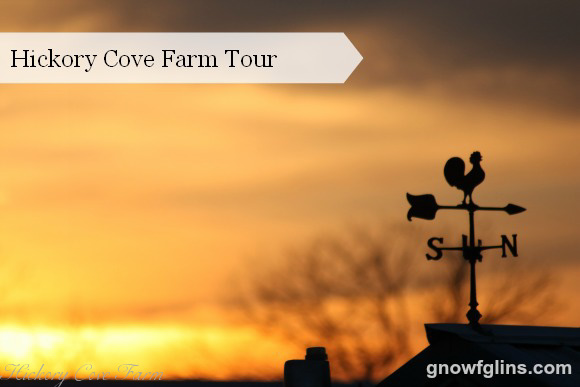
Lindsey Proctor’s first post here is an unofficial, and beautiful, contribution to our Down Home Farm Tours series. We’re still accepting applications for the 2013 season, by the way; details are here. –Wardee
Hello everyone! I’m so honored and excited to be part of the team of contributors here at GNOWFGLINS!
For my first post, I thought it would be a good idea to do a tour of my family’s farm. That way, as I talk about it in future posts, you can have an idea of where and what I’m referring to.
First, a bit about Hickory Cove Farm. We’re just a small place, about 8 acres, located in the Cumberland Valley in South-Central Pennsylvania. My parents, sister, and I are all very involved in the farm and we all share the work to keep things running smoothly. We raise Alpine and Nubian dairy goats, chickens, and usually, a beef steer. Although if we are able to find a good local source of grass-fed beef, we’d like to expand our dairy goat herd and perhaps raise meat goats such as Kikos or Boers instead of a steer.
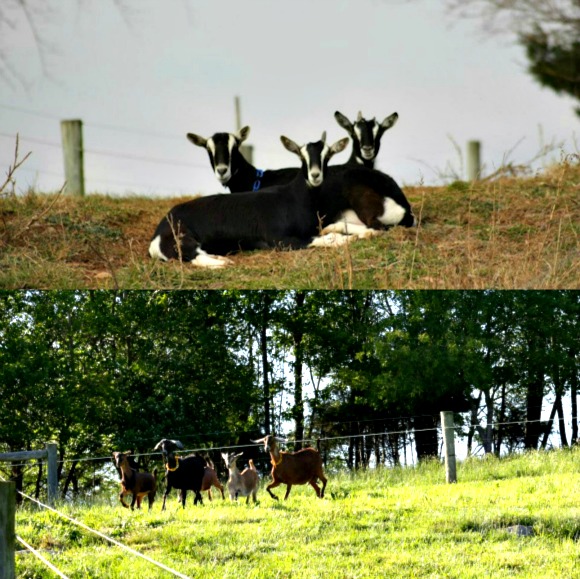
Currently, our goat herd consists of nine goats — four Alpines, two Nubians, and three Nubian/Alpines. We have three does in milk, two dry yearlings, and four growing kids. Two of the kids are owned by my friend, who is training them to drive (pull a goat cart) but they are boarding here indefinitely. Our goats have 24/7 access to a large pasture area, fresh water, loose minerals, and Thorvin kelp. Their diets are supplemented by good-quality hay and various amounts of soy-free, organic, non-GMO grain, depending on their ages and current needs. We enjoy the many benefits of fresh, raw goat’s milk and all the dairy products we’re able to make!
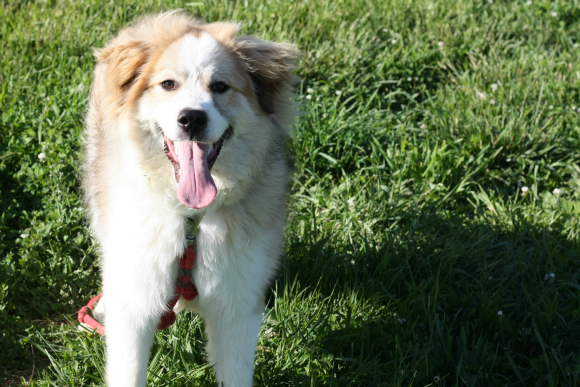
I am in the process of training our Great Pyrenees/Karakachin puppy, Mindy. Through a combination of training, good breeding, and instinct, she is blossoming into a wonderful Livestock Guardian Dog. Right now, she is allowed with the goats under indirect supervision, and stays in her own pen in the barn at night and when we are away. She can still have contact with the goats when she’s in her pen.
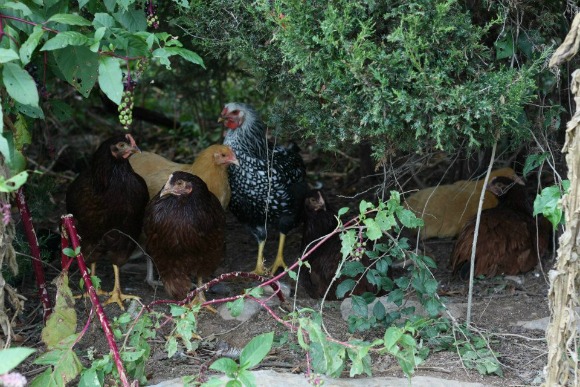
We keep a colorful flock of several different breeds chickens. My sister, resident Chicken Girl, cares for them. The flock free-ranges under the watchful eyes of three roosters, and they spend most of the day foraging for chicken delicacies like worms, slugs, and spiders, greens, and the occasional mole or mouse. The hens also get organic, soy-free, non-GMO laying mash. They supply us with a steady stream of fresh, dark-yolked, nutritious eggs.
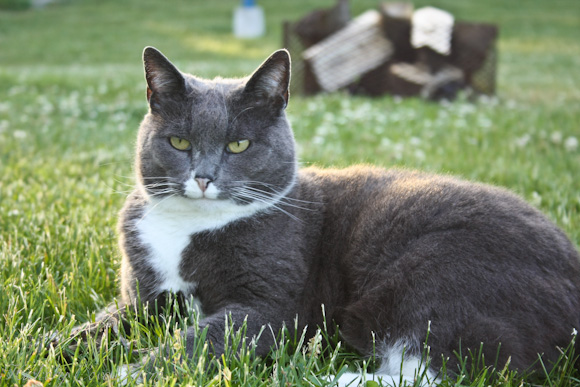
And I can’t forget our spoiled rotten kitty, aka Resident Rodent Patrol, Mr. Whisper!
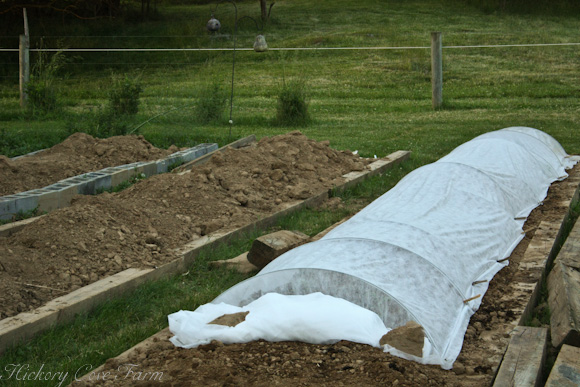
We also have a rather large garden, a strawberry patch, and some blueberry bushes. This is our first year trying the raised bed method for our garden, and we got them in much later than planned, so there isn’t too much growing in there right now. But, we’ll do what we can with what we have, and thankfully we’ll be able to do fall planting for most of what we missed getting in the ground in the spring. In addition to what we purposely grow, we’ve been able to identify and use many wild edibles and berries.
The Lay of the Land
Hopefully, the following photos will help you gain a sense of how things are laid out and what the farm looks like. Come along on a walk around the farm with me!
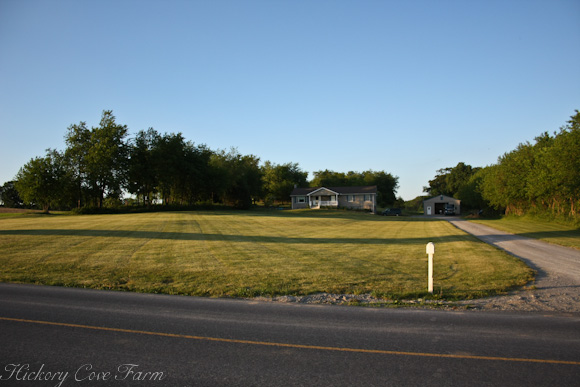
This is what you see from the road. Our house is back in quite a ways, so we have a large front lawn. We have plans of turning part of it into a small orchard some day soon. That’s the house on the left, of course, and the barn/Dad’s garage is on the right. The front part of the building is the garage, and the back part is our barn. Let’s walk up the driveway, through the garage, and into the barn.
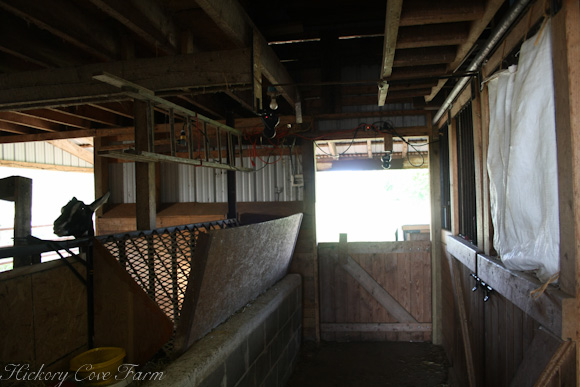
Here it is! On the left is a large stall/loafing area and hay manger. That’s goofball Charlotte peeking over the top. At the other end of the manger is a small opening for an access area to that side, with a small door so we can keep the goats out for most of the day, but let them through for milking. On the right, there are two stalls, since the barn was built for housing cows and horses. The first stall is our milk room, and the plastic is there to keep the birds out. The second stall is the one we use for a kidding stall, quarantine pen, and “bedroom” for the kids when they are at the in-between age and aren’t weaned but are being separated at night so we can milk their dams in the mornings.
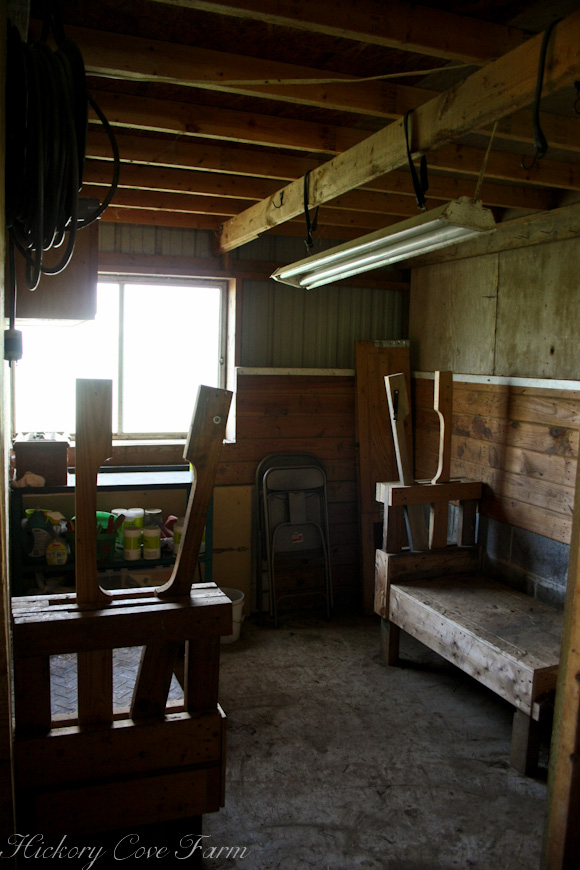
This is our milk room. Dad built both milk stands, adapted slightly from the plans found at Fiasco Farm. My sister and I do the milking while Mom takes care of feeding the other goats and filling water buckets and hay racks. At the moment we are only milking once a day and just feeding on the stands in the evening, but soon the kids will be weaned and we will milk in the morning and evening.
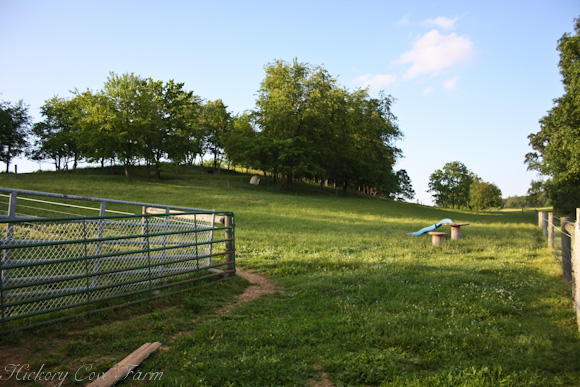
We’ll walk down the short hallway to the Dutch door, through the door, and into what we call the lower pasture. As mentioned, the barn was built for cows on one side and horses on the other, which means we also have two pastures. Right now, the Nubians and babies are all in this pasture, but when it is time to wean the kids, the does will be moved to the upper pasture, our buckling and two wethers will be moved to the buck pen, and this pasture will be empty for awhile. This will help us set up a pasture rotation system.

Here’s a photo looking back toward the barn. You can see how it’s divided, as well as the gates and fence that divide the pastures.
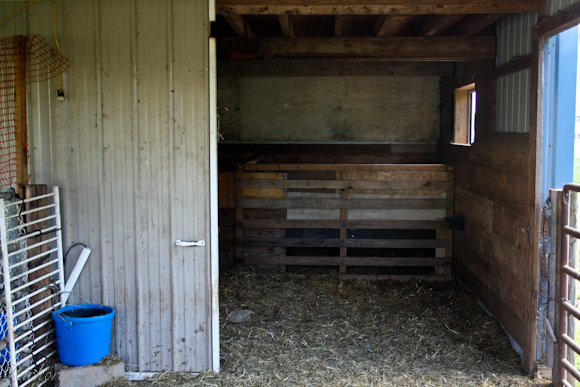
Moving to the upper pasture area, here’s a view looking into the large stall and Mindy’s pen. The lower pasture is to the left.
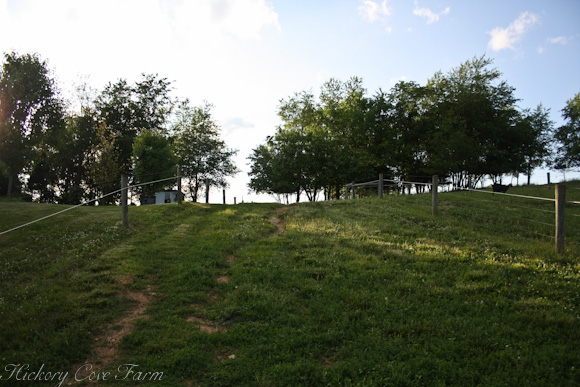
If we were to make a quarter turn to the right from where we were standing for the last picture, this is what we’d see. The barn is to the left, the lower pasture fence is on the right. You can see how both pastures share two fence lines.
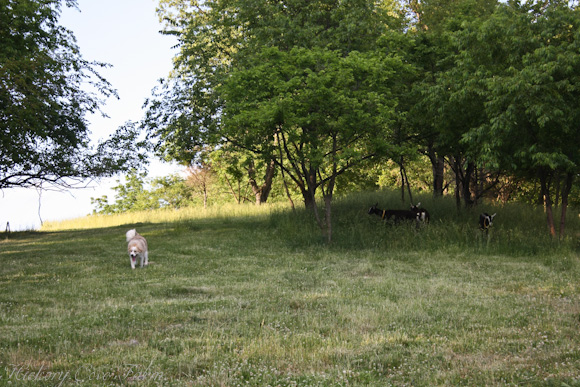
This is what we see when we walk up to the top of the hill in the previous photo and make another quarter turn to the right. There are Mindy and the Alpines! And when we walk to the top of this hill, past the dog…
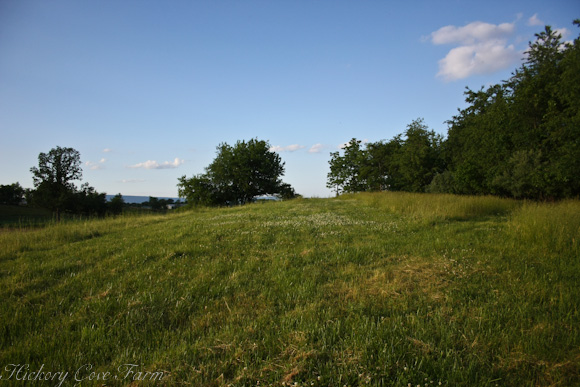
… we’ll see most of the rest of the upper pasture.
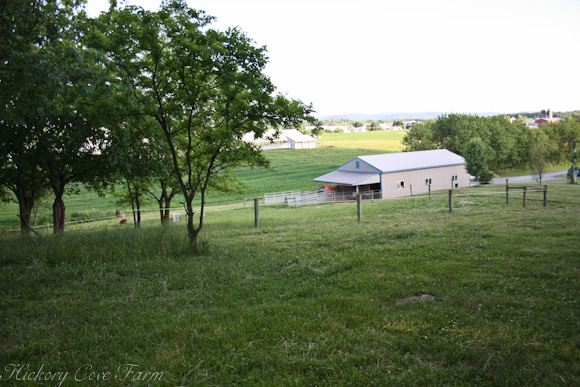
Here’s a shot, taken from the upper pasture, looking back at the barn.
Now, let’s walk back down the hill, through gate that divides the upper and lower pastures, through the other gate leading out of the lower pasture, and turn to our left. We are now facing the back of the property, and the area that gave the farm its name.
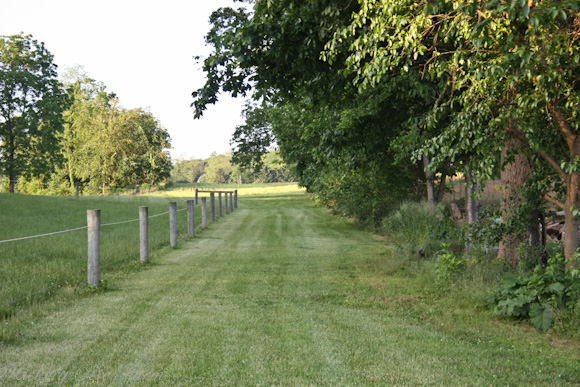
This narrow strip which runs along the lower pasture leads to the area we call The Cove, and it is the only part of the property where we’ve found a few hickory trees. I haven’t been able to identify exactly which species of hickory they are, but I know they aren’t Shagbark.
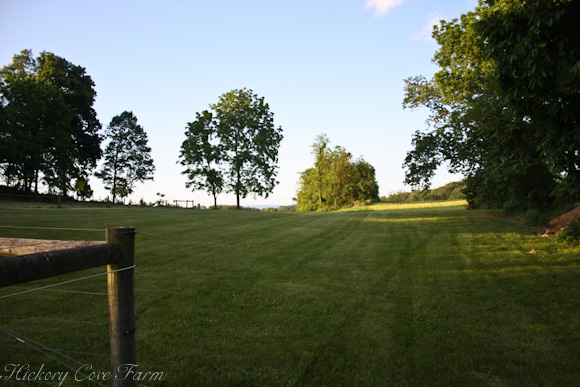
The Cove. I have fond memories of camping back here before we built on the land, and picking mulberries from the trees — which are now inside the fence — by climbing on a hay wagon to reach them all. The jury is still out on what we’re going to do with this area – leave it as is, plant some alfalfa, or maybe even put a small cabin or a yurt back here.
Now, let’s walk back toward the barn, past it, make a quarter turn to the right, and walk through the backyard to the garden and chicken coops.
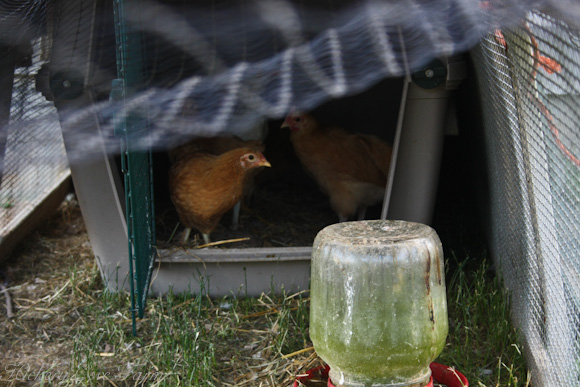
On the way, we’ll pass the small run where our 6 “teenage” chicks are living until they’re old enough to join the main flock.
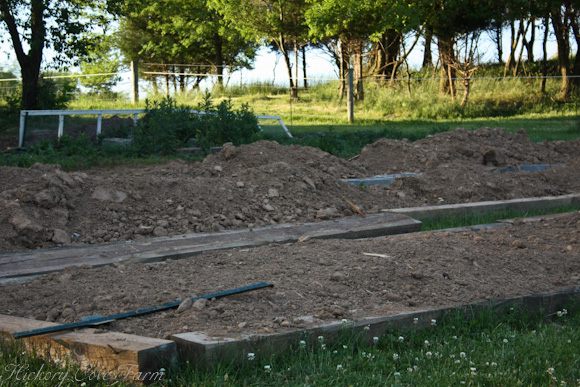
Here are the garden beds, before we’d planted anything in them. That’s the upper pasture fence in the background.
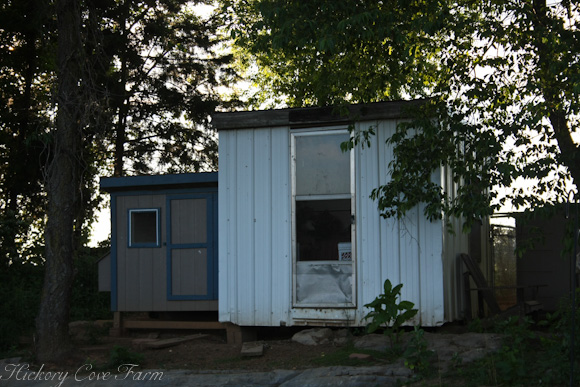
Make one more quarter turn to the left, and you’ll see the chicken coops. They’re separate, but both have access to a shared small run area in the back, with a gate that gets opened in the morning to allow them to free-range, and closed at night to protect them from night-time predators.
Thanks for walking along with me!
Hopefully now you have an idea of what we do and what things look like around here. Don’t be shy now! If you have questions or need further clarification, leave a comment and let me know!
...without giving up the foods you love or spending all day in the kitchen!
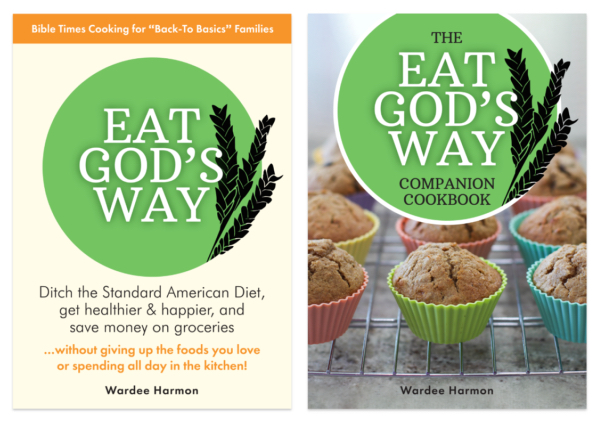
2 free books:
Eat God's Way
Ditch the Standard American Diet, get healthier & happier, and save money on groceries...
We only recommend products and services we wholeheartedly endorse. This post may contain special links through which we earn a small commission if you make a purchase (though your price is the same).


Thanks for giving us a tour of your farm, Lindsey. I love seeing what you and your family are doing with your land. So inspiring!
Neat tour, Lindsey! 🙂 Looking forward to reading more from you!! Have you experimented with goat milk soap at all? I’m excited for all the wonderful dairy someday when we have goats of our own, but I want to play with soap making, too! 🙂
We have! We’ve made two batches of cold process soap and it’s time to make another batch, but I need to order some more essential oils first. 🙂 It’s quite easy and fun to do, and the soap feels very creamy and soft.
Thanks Lindsey, these pictures are great, it is wonderful to see so much of where you guys live and everything that you do! I really enjoyed seeing this 🙂
Good to see you, Yolla!
Lindsey thank you so much for the tour! I really enjoyed seeing your beautiful farm. We just moved out to our acreage last fall and just *last week* got our chickens. We would love to have dairy goats someday and a livestock guardian dog. We have shih-tzus but I don’t think they’re into guarding the property. Much too indulged. 😛 What you are doing with your family is so inspiring. Can I ask where you get the feed for your chickens?
Thank you for your kind words! And congrats on the chickens – they seem to be the gateway animal for homesteading. 🙂
We get our feed for both the chickens and goats from a local man who started his own little mill after getting tired of running to Lancaster to pick up feed for his pastured broilers. I’ve asked where he gets the grains from – at the moment he’s getting them from a farmer who is in the transitional phase, which means the farmer is heading toward a USDA Organic certification and is transitioning his fields from conventional to organic and using organic non-GMO seeds and no sprays, but doesn’t have his certification yet. Our feed man is going to start growing some of his own grains as well.
If you’re looking for a good feed for your chickens and can’t find anything locally, Scratch and Peck seems to be a good choice. 🙂
Wonderful tour! Thank you!! I love your land… so green. (We live on a high prairie and it’s pretty much never that green. Ever.) And more importantly, I love what you are doing with it. 🙂
It’s amazing how similar your pasture area looks to ours here in Oregon! I haven’t had the pleasure of visiting Pennsylvania, but your photos are beautiful. I look forward to reading more from you!